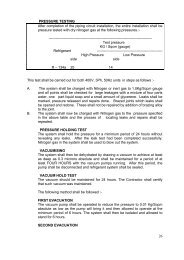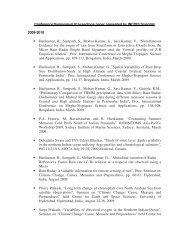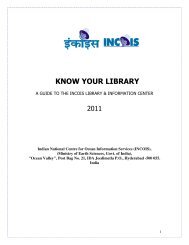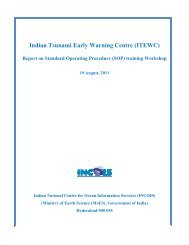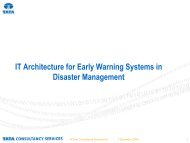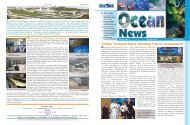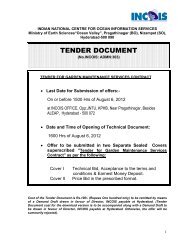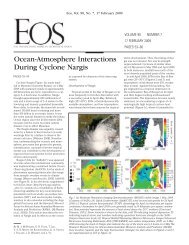Michael P. Finn and Barbara S. Poore
Michael P. Finn and Barbara S. Poore
Michael P. Finn and Barbara S. Poore
Create successful ePaper yourself
Turn your PDF publications into a flip-book with our unique Google optimized e-Paper software.
U. S. Department of Interior<br />
U. S. Geological Survey<br />
Joint International Workshop of ISPRS WG IV/1, WG VIII/1 <strong>and</strong> WG IV/3<br />
on<br />
Geospatial Data Cyber Infrastructure <strong>and</strong> Real-time Services with special<br />
emphasis on Disaster Management<br />
November 25-27, 2009<br />
Hyderabad, India<br />
<strong>Michael</strong> P. <strong>Finn</strong> <strong>and</strong> <strong>Barbara</strong> S. <strong>Poore</strong>
Motivation<br />
The National Map<br />
NRC Report: Goals <strong>and</strong> Research<br />
User-Centered Design<br />
Information Access <strong>and</strong> Dissemination: OGC St<strong>and</strong>ards<br />
<strong>and</strong> Web Services<br />
Viewer Design <strong>and</strong> Web 2.0 Technologies<br />
Scenario <strong>and</strong> Research<br />
Summary
The National Map Vision<br />
A seamless, continuously<br />
maintained, nationally consistent<br />
set of base geographic data<br />
Developed <strong>and</strong> maintained<br />
through partnerships<br />
A national foundation for<br />
science, l<strong>and</strong> <strong>and</strong> resource<br />
management, recreation, policy<br />
making, <strong>and</strong> homel<strong>and</strong> security<br />
Available over the Internet<br />
The source for revised<br />
topographic maps
The National Map contributes to the NSDI<br />
The National Map includes eight data layers<br />
Public domain data to support<br />
USGS topographic maps at 1:24,000-scale<br />
Multiple scales <strong>and</strong> resolutions: Products,<br />
services, analysis, modeling <strong>and</strong> other<br />
applications<br />
The National Map is built on partnerships <strong>and</strong><br />
st<strong>and</strong>ards
Transportation<br />
Structures<br />
Orthoimagery<br />
Hydrography<br />
L<strong>and</strong> Cover<br />
Geographic Names<br />
Boundaries<br />
Elevation
Priority research topic for CEGIS according to<br />
National Research Council Report<br />
Interactive process of system development<br />
linking developers with users at every stage<br />
Major research area in computer science <strong>and</strong><br />
human-computer interaction<br />
Long tradition in cartography; flurry of GIS<br />
research in mid 1990’s
Meets requirements!<br />
yes no<br />
5. Evaluate<br />
designs against user<br />
requirements<br />
1. Plan the human<br />
centered process<br />
2. Specify the<br />
context of use<br />
4. Produce design<br />
solutions<br />
3. Specify user<br />
<strong>and</strong> organizational<br />
requirements<br />
ISO 13407: Human centered design processes for interactive systems
Example: Scenario-Based Design<br />
(Rosson <strong>and</strong> Carroll 2002)
Spatial information can be a unifier of many<br />
technology disciplines<br />
Focusing on st<strong>and</strong>ard profiles<br />
A key challenge is to produce st<strong>and</strong>ard profiles<br />
that are customized for USGS products
Who are users of The National Map products<br />
now <strong>and</strong> in next 5 years?<br />
How are user behaviors changing as a result of<br />
Web 2.0 technologies?<br />
What types of interfaces are appropriate for<br />
traditional <strong>and</strong> new categories of users?
Open source<br />
Rise of the user (person, group, firm)<br />
Direct physical manipulation of map interface<br />
User-contributed data<br />
Social networking<br />
Co-production of content
E-Topo<br />
Maps<br />
User-Centered<br />
Design<br />
Generalization<br />
Quality<br />
Aware<br />
Authoritative<br />
Data Source<br />
Nationwide Coverage 8<br />
Data Layers<br />
Intelligent Knowledge Base<br />
Semantics-driven<br />
Integrated<br />
Data<br />
Multiscale<br />
Feature/<br />
Event<br />
Based<br />
Spatio-<br />
Temporal<br />
Ontology<br />
Driven
Wildfires are spreading rapidly across a San Diego mountainside. Fire fighters<br />
have deployed with two-way radios <strong>and</strong> Global Positioning Systems (GPS). In<br />
the comm<strong>and</strong> center, the new 3-D topographic maps overlaid with near real-time<br />
airborne color-infrared thermal imagery, real-time GPS wireless sensor data, <strong>and</strong><br />
National Weather Service maps of wind direction, precipitation potential, <strong>and</strong><br />
temperature displayed on the computers allow the comm<strong>and</strong> center team to tell<br />
the fire fighters through their two-way radios where the wildfire boundaries are<br />
<strong>and</strong> help them estimate the likely fire spread directions <strong>and</strong> speed in the next two<br />
hours. The operators at the comm<strong>and</strong> center find it intuitive to toggle between the<br />
various layers of data to analyze the situation, <strong>and</strong> can select different<br />
combinations to produce PDF files for fast printing to distribute to the crews.<br />
Meanwhile, the GPS <strong>and</strong> wireless communication enable the transmission of the<br />
position of the crew back to the comm<strong>and</strong> center, which has a large screen to<br />
display the overview maps with current positions of all firefighters <strong>and</strong> current<br />
fire perimeters. With a comprehensive GIS modeling technology <strong>and</strong> the<br />
information provided from The National Map (topography, slope, aspect,<br />
weather, soil moisture, vegetation, etc.), the comm<strong>and</strong> <strong>and</strong> control center<br />
calculates potential dangers for firefighters <strong>and</strong> immediately distributes a<br />
warning to the crews on the west side of the mountain to relocate 300 m farther<br />
west. Based on information from the overview maps, the center also dispatches<br />
another crew to the highest-risk zone <strong>and</strong> moves two more toward that zone.<br />
Their earlier participation in design phases are paying off in powerful but easy to<br />
use geospatial tools in a frantic <strong>and</strong> hostile environment.
Immediate access to information based on common<br />
place name<br />
Intuitive user interface, semantically-driven<br />
Automated generalization <strong>and</strong> data integration<br />
(fusion, conflation)<br />
Semantics driven query <strong>and</strong> access
Ontology-driven generalization, data integration,<br />
user-interfaces, <strong>and</strong> map generation
The National Map: A seamless, continuously maintained,<br />
nationally consistent set of base geographic data<br />
NRC Report: vision for 2015<br />
Information Access <strong>and</strong> Dissemination -> User-Centered<br />
Design<br />
User-Centered Design : Priority research topic for CEGIS<br />
OGC St<strong>and</strong>ards <strong>and</strong> Web Services: St<strong>and</strong>ards for USGS<br />
products<br />
Viewer Design <strong>and</strong> Web 2.0 Technologies: Design for users<br />
now <strong>and</strong> in next 5 years; emphasize open source<br />
Scenario <strong>and</strong> Research: Immediate access, Intuitive user<br />
interface, Generalization , Integration (ontology-driven map<br />
generation)<br />
Many USGS geospatial products are already built on OGC<br />
st<strong>and</strong>ards<br />
Normalize access to spatial data
Joint International Workshop of ISPRS WG IV/1, WG VIII/1 <strong>and</strong> WG IV/3<br />
on<br />
Geospatial Data Cyber Infrastructure <strong>and</strong> Real-time Services with special<br />
emphasis on Disaster Management<br />
November 25-27, 2009<br />
Hyderabad, India<br />
<strong>Michael</strong> P. <strong>Finn</strong> <strong>and</strong> <strong>Barbara</strong> S. <strong>Poore</strong><br />
mfinn@usgs.gov<br />
bspoore@usgs.gov<br />
http://cegis.usgs.gov/index.html



